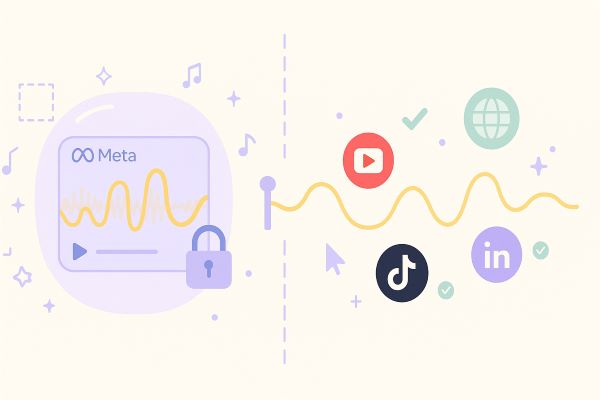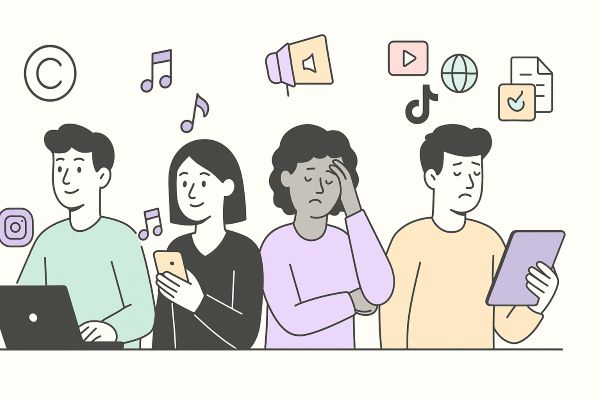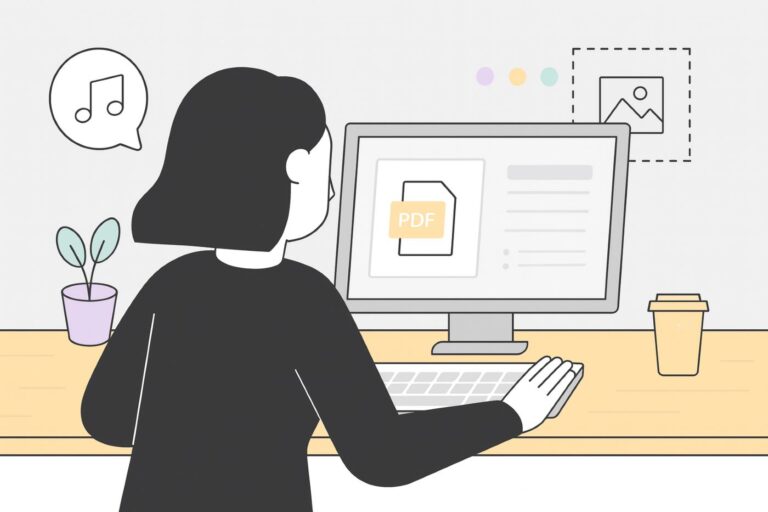Music License Cost: How Much You’ll Pay and What Affects the Price
Audiodrome is a royalty-free music platform designed specifically for content creators who need affordable, high-quality background music for videos, podcasts, social media, and commercial projects. Unlike subscription-only services, Audiodrome offers both free tracks and simple one-time licensing with full commercial rights, including DMCA-safe use on YouTube, Instagram, and TikTok. All music is original, professionally produced, and PRO-free, ensuring zero copyright claims. It’s ideal for YouTubers, freelancers, marketers, and anyone looking for budget-friendly audio that’s safe to monetize.
Let’s break down music licensing in a way that actually makes sense. If you create videos, podcasts, ads, or any other kind of media, you’ve probably wondered – How much does music cost? The truth is, it varies a lot. Some tracks are extremely affordable, while others can cost thousands. The average pricing can swing widely. It all depends on the type of license you need and the scale of your project.
If you’re a content creator, it’s important to understand the main pricing options. There are pay-per-track, subscription plans, custom licenses, and even free resources – each designed for different budgets and creative needs.
In this guide, we’ll break down how each model works, plus take a closer look at buyout licensing and how it stacks up against recurring subscriptions. By the end, you’ll have a clear idea of which option fits your workflow (and your wallet).
Prising Models that Dominate the Licensing Market
Across film sets, YouTube studios, and cafés, eleven pricing models move almost all licensed music. They dominate because each offers a sharp trade‑off between upfront cost, legal protection, and the time it takes to drop a track into a project.
Pick poorly and you risk claims, overpayments, or losing rights after cancellation. Choose wisely and you lock predictable budgets and global rights. The call hinges on publish frequency, audience size, and money riding on the sound.
Here are the most common models:
- Micro‑Licensing – Flat micro‑fees (often <$10) for very limited online or local use.
- Pay‑Per‑Track – One‑off fee per song; price scales with audience size or medium.
- Credit‑Pack / Token – Pre‑buy a bundle of credits and spend them per download.
- Subscription – Pay monthly or yearly for unlimited downloads from an entire catalogue.
- Tiered / Usage‑Based – Same track, multiple price tiers tied to reach (student, small business, broadcast, theatrical).
- Blanket / Annual Enterprise – One negotiated fee unlocks unlimited catalogue use for a set period.
- Revenue‑Share – No upfront fee; rights‑holder takes some or all ad revenue via Content‑ID or platform pool.
- Custom / Exclusive Commission – Pay a composer upfront for bespoke music; terms set per project.
- Buyout (Full Rights) – Pay a premium once and own or control the track forever – no future royalties or renewals.
Each model is designed for different project sizes, budgets, and creative needs. The key is finding the one that fits your workflow.
Free Models
Free licensing options give you a risk‑free starting point, but they still demand that you understand the legal ground beneath your feet.
Public‑Domain Access
Many works from the 1800s and early 1900s have outlived copyright, and some modern composers have also donated their music to the public domain. That means no one owns the notes – you can copy, remix, and sync them without paying a fee.
Picture a history teacher cutting a Civil War documentary. She finds a lively 1860s march, records a new version with her school band, and drops it straight into the edit. No permissions, no invoices, no delay.
Because you created a new recording, broadcasters still need a public‑performance licence from the local PRO. Clear that single step and you can share, stream, or sell the film worldwide without extra music costs.
Creative Commons “Free With Conditions”
Creative Commons licences let artists share their work under clear rules. The letters tell you the deal: “BY” means give credit, “NC” means no commercial use, and “SA” means share remixes under the same licence.
A science‑fair team shoots a demo of their volcano experiment and chooses a CC‑BY indie track. They add a neat credit slide (artist name, track title, licence link) and keep the project non‑commercial.
Meet every condition and you’re covered for sync and mechanical rights. If the video later airs on local TV, the station only needs its standard PRO blanket to clear public performance.
Freemium Library (Personal‑Free / Commercial‑Upgrade)
Freemium sites hook creators with a personal‑use tier that costs nothing. You get basic sync and mechanical rights for hobby videos, family slideshows, or social posts without ads.
A skate vlogger grabs a free punk riff for her clips. Months later, a board company offers sponsorship. She upgrades to the commercial tier, which unlocks ad clears, broader reach, and even offline use.
Read the fine print: monetised streams, affiliate links, or brand deals can flip a “personal” video into the paid zone. Upgrade early to avoid takedown notices and keep your channel in good standing.
Micro‑Licensing
Micro‑licensing shrinks traditional fees down to coffee‑money levels, often a few dollars per track, for ultra‑specific uses like a single Instagram ad or a local TV spot that airs just a handful of times. Because rights are tightly limited in duration, territory, and audience reach, libraries can sell thousands of these micro‑syncs without cannibalising higher tiers.
The model is perfect for solo creators and small businesses that need legal music but can’t stomach larger buyouts. Just remember that upgrading even one element, say, expanding the ad to national TV, forces a brand‑new licence.
How it works: Library pre‑sets strict caps (e.g., 50,000 online impressions or one local broadcast market) and charges a flat micro‑fee.
Cost range: $3 - $15 per cue.
Best for: Local cafés, indie app trailers, social‑ad experiments where reach is modest and shelf‑life is short.
Pay‑Per‑Track
Pay‑per‑track keeps things simple: pick a song, pay once, and lock rights for the usage defined at checkout. Prices balloon or shrink based on audience size, medium, and term length, so you never subsidise somebody else’s blockbuster. If a project later scales (festival run turns into a streaming deal), just upgrade the license.

Because fees are one‑off, paperwork stays minimal, making this model ideal for productions with limited cue sheets or tight edit calendars. However, stacking multiple songs can quickly outstrip subscription costs.
How it works: One‑time sync + master fee tailored to project scope; upgrades cost extra.
Cost range: $20 for student films up to $1 000+ for national TV.
Best for: Indie shorts, single‑spot commercials, game menus – any project needing just a handful of tracks.
Credit‑Pack / Token
Credit packs act like a prepaid punch card. Studios buy a block of tokens upfront, often at volume discounts, and burn them as needed. The frictionless checkout lets editors grab music on deadline without reaching for a credit card each time.
Unused credits can expire, and “premium” tracks may cost multiple tokens, so track usage to avoid surprises. Still, the model balances flexibility with predictable spend, especially for agencies juggling unpredictable workloads.
How it works: Pre‑pay 10-500 credits; each standard license deducts one.
Cost range: $2 - $12 per credit, falling with larger bundles.
Best for: Boutique post‑houses, seasonal content spikes, teams that can forecast annual music volume but not exact titles.
Subscription
Subscriptions swap piecemeal invoices for a flat recurring bill. With unlimited downloads, creators focus on storytelling instead of budgeting each cue. Most libraries grandfather published content after cancellation, but some require an active plan for continued public display, so archive licences carefully.

Because music is non‑exclusive, overlap with rival channels is possible. Brands needing sonic distinctiveness should weigh that risk against cost savings.
How it works: Monthly or annual fee unlocks entire catalogue; sync + mechanical bundled, PRO royalties separate.
Cost range: $15 - $50 / month or $120 - $300 / year.
Best for: High‑volume YouTubers, social agencies, e‑learning platforms pushing dozens of videos per month.
Tiered / Usage‑Based
Tiered pricing sells the same track at stair‑step rates (student, small business, broadcast, theatrical), based on reach and medium. Creators pay only for the exposure they actually need, while libraries protect top‑end value for blockbuster clients.
Moving a project up the ladder later is easy but never free – plan for future growth or budget for upgrades. Clear tier definitions also simplify client quotes: just match the project to its bracket.

How it works: Library links price to audience size (views, ad spend, seats) and media type.
Cost range: $10 classroom licence to $2 000+ global cinema rights.
Best for: Agencies juggling varied client sizes, indie filmmakers hoping for future distribution deals.
Blanket / Annual Enterprise
A blanket licence is bulk music at wholesale. One negotiated fee gives a company’s editors 24/7 access to a full catalogue for a year (or longer). No per‑track invoices mean predictable ledgers and faster edits – priceless for broadcasters on tight deadlines.

Because cost is front‑loaded, the model only pays off if you truly exploit the library. Annual audits help prove ROI and inform renewal talks.
How it works: Sync, mechanical, and transcription rights are bundled across all tracks for the licensed entity.
Cost range: $5 000 - $50 000+ per year, depending on catalogue size and audience footprint.
Best for: TV networks, large agencies, streaming start‑ups with heavy content pipelines.
Revenue‑Share
Some libraries ditch upfront fees and earn through ad splits. Add the track for free, and platforms like YouTube divert a pre‑agreed slice of revenue to the rights‑holder via Content‑ID. Great for cash‑strapped channels, risky once your CPMs climb.

Sponsors often require ad‑free uploads, turning rev‑share music into a liability. Keep project files editable so you can swap tracks before a big deal lands.
How it works: Sync auto‑granted; rights‑holder collects 20-100 % of ad revenue.
Cost range: $0 upfront; long‑term earnings sacrificed.
Best for: Experimental channels, proof‑of‑concept videos, creators prioritising reach over revenue.
Custom / Exclusive Commission
When brand identity or narrative cohesion matter, off‑the‑shelf cues won’t cut it. Hiring a composer secures a unique score, timed and tailored to every beat of the edit. Contracts can range from full buyouts to royalty splits.
Lead time and cost are higher, but the result avoids Content‑ID clashes and grants total sonic control. Plus, you can market the score as a standalone asset.
How it works: Composer delivers music under bespoke terms; client pays fee plus possible backend royalties.
Cost range: $500 for indie jingles to $100 k+ for AAA game scores.
Best for: Feature films, high‑end ads, and flagship podcasts seeking a signature theme.
Buyout (Full Rights)
A buyout is the nuclear option: pay once, own it forever. You acquire or control both master and publishing, eliminating future royalties and clearance headaches. The premium reflects that lifelong freedom – and the composer’s loss of ongoing income.
Perfect for products that ship globally and live forever (toys, apps, theme‑park rides), buyouts also future‑proof against format shifts and new media platforms.
How it works: One‑time lump sum transfers all exploitable rights; no PRO payouts unless contract carves them out.
Cost range: Mid‑four figures for short cues to high six figures for chart‑quality songs.
Best for: Global brands, permanent installations, tech products embedding music in hardware or firmware.
Quick Comparison of Licensing Cost Models
| License Type | Cost Range | Best For | Restrictions |
|---|---|---|---|
| Micro‑Licensing | $5 – $50 per track | Local ads, limited‑reach social posts, student films | Caps on audience, duration, and territory; any expansion needs a new licence |
| Pay‑Per‑Track | $20 – $1 000+ per track | Indie films, single TV or radio spots, game menus | Adding more songs or widening distribution drives total cost up fast |
| Credit‑Pack / Token | $2 – $12 per track after bundle purchase | Boutiques and agencies with uneven project flow | Credits can expire; premium cues may cost multiple tokens |
| Subscription | $15 – $50 / month or $120 – $300 / year | High‑volume YouTubers, e‑learning teams, social agencies | Some services require an active plan for videos to stay cleared |
| Tiered / Usage‑Based | $10 classroom licence to $2 000+ global cinema | Agencies juggling clients of different sizes | Moving up a tier later costs extra; must track views or ad spend |
| Blanket / Annual Enterprise | $5 000 – $50 000+ / year | TV networks, large production houses, streaming startups | Front‑loaded fee; poor value if the catalogue isn’t used heavily |
| Revenue‑Share | $0 upfront; 20 – 100 % of ad revenue diverted | Cash‑strapped creators testing ideas | Ad‑free sponsorships become tricky; earnings fall as views rise |
| Custom / Exclusive Commission | $500 – $100 000+ per score | Feature films, flagship ads, games needing a signature theme | Longer lead times and contract negotiation; higher creative cost |
| Buyout (Full Rights) | $5 000 – $200 000+ one‑time | Global brands, products with decades‑long shelf lives | High upfront spend; changing the theme later means another buyout |
This table covers everything from pay-per-track to high-end commercial licenses. If you need a global TV ad or a feature film track, expect numbers in the thousands or tens of thousands for recognized music.
Key Factors That Push the Price Up or Down
Audience reach drives price first. A track heard by a classroom costs a fraction of the fee charged for a national prime‑time spot because more ears mean higher exposure and greater royalty potential for the composer.
Media type matters almost as much. Web‑only videos sit at the low end, podcasts and apps land in the middle, while theatrical releases and broadcast TV command premium rates due to wider distribution and stricter legal scrutiny.
Term length sets the meter running. Paying for one month keeps costs lean for short campaigns, but locking in a lifelong licence saves future upgrade fees when you want the same video live years later.
Exclusivity jumps the price quickest. Non‑exclusive library tracks stay cheap because many creators share them, but hiring a composer or buying a one‑brand buyout pushes the fee up by rewarding total control and uniqueness.
Territorial footprint closes the calculation. A licence confined to one country costs little, a multi‑territory licence costs more, and a global deal tops the scale because rights‑holders must manage compliance in every market.
Hidden Costs and Common Pitfalls
Performing rights royalties linger behind every licence. You rarely pay them directly; TV stations, cinemas, venues, and streaming platforms report the music they air and send money to societies such as ASCAP or PRS. Still, cue sheets you deliver fuel that system, so sloppy paperwork can delay payments or spark infringement claims.

File your cue sheets the moment you lock picture. They list each track’s title, composer, and timing, giving PROs the data they need. Miss the deadline and libraries may refuse future licences, or YouTube’s Content ID could flag your video. The same headache hits when you delay upgrading a licence after your audience or territory expands.
Plan for extra versions before you sign. Many licences treat every re‑edit, teaser, foreign‑language dub, or thirty‑second cut‑down as a fresh use. If you expect trailers, regional ads, or future director’s cuts, negotiate a bundle up front. Budgeting for versioning now keeps you from scrambling later and shields your project from sudden takedown notices.
Quick Checklist Before You Hit “Buy”
Pause before you check out. A one‑minute review now prevents takedowns and hidden fees later.
- Does the licence cover both the master recording and the underlying composition?
- Is the term long enough for every place the content will live?
- Could future sponsors, ads, or new platforms require a broader licence?
- Do you have a dated copy of the licence certificate stored safely?
- Did you budget for re‑edits, trailers, or language dubs if needed?
Still unsure? Run your details through our Music License Wizard or Cost Calculator for an instant estimate.
Music Licensing Cost Estimator
Sticker shock comes from not knowing what libraries weigh when they quote a fee. Music licensing cost estimator reverses the math and shows you a ballpark cost before you even speak to a sales rep.
Choose the project type, usage channel, track length, and territory. Behind the scenes, the calculator multiplies those four factors by a base rate drawn from recent industry surveys, then returns a low‑to‑high range that mirrors what most rights‑holders charge for a traditional sync licence. The result is fast, transparent, and close enough for budgeting, pitch decks, or client approvals.
Once you have that figure, compare it to Audiodrome’s flat‑rate licence displayed beneath the estimate. One number covers unlimited tracks, global reach, and future takedown protection, giving you an immediate sense of whether a per‑project sync fee or a subscription model will stretch your money further.
Music Licensing Cost Estimator
More inputs → tighter estimate. Guidance only, not a quote.
Estimated Licensing Ranges
Embed This Tool on Your Website


Audiodrome was created by professionals with deep roots in video marketing, product launches, and music production. After years of dealing with confusing licenses, inconsistent music quality, and copyright issues, we set out to build a platform that creators could actually trust.
Every piece of content we publish is based on real-world experience, industry insights, and a commitment to helping creators make smart, confident decisions about music licensing.















